

Total fertility rate — The World Factbook. People from nearly every country share information with CIA, and new individuals contact us daily.
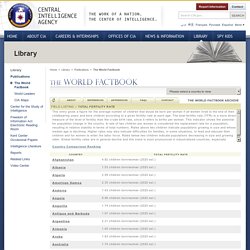
If you have information you think might interest CIA due to our foreign intelligence collection mission, there are many ways to reach us. If you know of an imminent threat to a location inside the U.S., immediately contact your local law enforcement or FBI Field Office. For threats outside the U.S., contact CIA or go to a U.S. Embassy or Consulate and ask for the information to be passed to a U.S. official. Please know, CIA does not engage in law enforcement. In addition to the options below, individuals contact CIA in a variety of creative ways.
If you feel it is safe, consider providing these details with your submission: Your full name Biographic details, such as a photograph of yourself, and a copy of the biographic page of your passport How you got the information you want to share with CIA How to contact you, including your home address and phone number. Japan prime minister 2020. Image result for japan cabinet 201. Japan emperor. 8 Japanese routines for a happy & healthy life. 2.

Shinrin-yoku To find peace and recovery, the Japanese practice something called shinrin-yoku, or “forest bathing”. Taking a forest bath means immersing yourself in a forest for several hours and soaking up its sights, smells and sounds. Simply being in a forest and absorbing its atmosphere has a restorative effect on the body and mind. The science-backed mental and physical health benefits of this popular wellness ceremony include reduced stress levels, improved sleep, increased focus and creativity, accelerated recovery from illness, a strengthened immune system and a higher sense of overall happiness. 10 Japanese traditional rituals to give every child a happy life. 1.
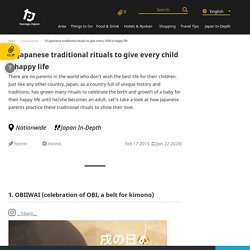
OBIIWAI (celebration of OBI, a belt for kimono) The first "dog day" of the fifth month of the pregnancy is the day to do the ritual called OBIIWAI. This is the ceremony to tie a cotton belt around a woman's abdomen to protect a baby. People usually go to a shrine to do this ceremony praying for a safe delivery and a healthy baby. Japanese Culture - Food & Drink - The Basics. The typical Japanese meal consists of a bowl of rice (gohan), a bowl of miso soup (miso shiru), pickled vegetables (tsukemono) and fish or meat.
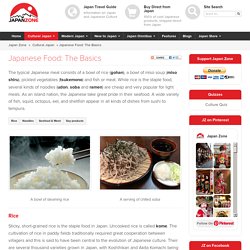
While rice is the staple food, several kinds of noodles (udon, soba and ramen) are cheap and very popular for light meals. Image result for Jōmon period, ca. 10,000–300 B.C. ar. Asian Art at the Princeton University Art Museum. Japanese Literature. Writing was introduced to Japan from China in the 5th century via Korea.
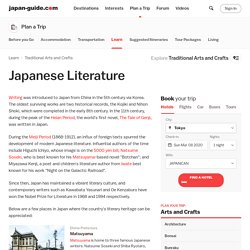
The oldest surviving works are two historical records, the Kojiki and Nihon Shoki, which were completed in the early 8th century. In the 11th century, during the peak of the Heian Period, the world's first novel, The Tale of Genji, was written in Japan. During the Meiji Period (1868-1912), an influx of foreign texts spurred the development of modern Japanese literature. Influential authors of the time include Higuchi Ichiyo, whose image is on the 5000 yen bill; Natsume Soseki, who is best known for his Matsuyama-based novel "Botchan"; and Miyazawa Kenji, a poet and children's literature author from Iwate best known for his work "Night on the Galactic Railroad". Since then, Japan has maintained a vibrant literary culture, and contemporary writers such as Kawabata Yasunari and Oe Kenzaburo have won the Nobel Prize for Literature in 1968 and 1994 respectively.
A Guide to Traditional Japanese Art Forms. Japan is a country immersed in cultural appreciation.
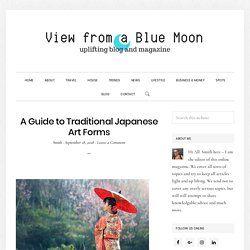
Outsiders are often fascinated at how the Japanese people embrace their culture and incorporate it with the stark modernity of today’s Japanese society. There are many traditional Japanese art forms alive and well-celebrated today. Some of these art forms have even found their way to western countries. Characteristics of Japanese Art Style.
4 Characteristics of Japanese Art - Gabrielaanastasio.com. Throughout the centuries, art has been a form of communication between people, and it is a huge part of every culture around the world.

It brings meaning and purpose to humanity by trying to interact with the audience through their creations. While looking at art in Asian countries, it is crucial to understand that Asia has many diverse cultures. For example, Japanese art is fascinating because it was not influenced by the western world until the 19th century. Since it has been isolated from other art influencers, it has a truly exotic touch. Thus, Japanese art has its own characteristics, which makes it even more impressive and unique. Learn more about art. Fundamental Structure of the Government of Japan. Emperor.
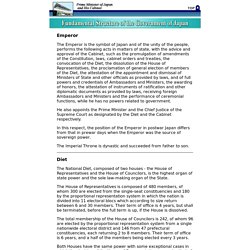
The Government of Japan - JapanGov - Japanese Government: Historical vs. Contemporary. Meet the Gods: 13 Japanese Kami - Japan Talk. Japan » guide » temples and shrines » kami posted by John Spacey, October 12, 2015 Kami are the spirits, gods and deities of Japan's Shinto religion.
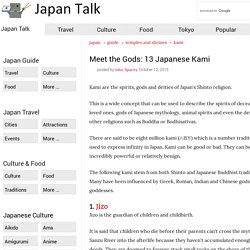
This is a wide concept that can be used to describe the spirits of deceased loved ones, gods of Japanese mythology, animal spirits and even the deities of other religions such as Buddha or Bodhisattvas.There are said to be eight million kami (八百万) which is a number traditionally used to express infinity in Japan. Kami can be good or bad. They can be incredibly powerful or relatively benign. The following kami stem from both Shinto and Japanese Buddhist traditions. Jizo is the guardian of children and childbirth.It is said that children who die before their parents can't cross the mythical Sanzu River into the afterlife because they haven't accumulated enough good deeds. Religion in Japan. Shinto and Buddhism are Japan's two major religions.

Shinto is as old as the Japanese culture, while Buddhism was imported from the mainland in the 6th century. Since then, the two religions have been co-existing relatively harmoniously and have even complemented each other to a certain degree. Most Japanese consider themselves Buddhist, Shintoist or both. Religion does not play a big role in the everyday life of most Japanese people today. The average person typically follows the religious rituals at ceremonies like birth, weddings and funerals, may visit a shrine or temple on New Year and participates at local festivals (matsuri), most of which have a religious background. What Type Of Government Does Japan Have? Japan's government is a constitutional monarchy where the Emperor's power is limited to mainly ceremonial duties. The government has three branches: the executive, legislature, and the judiciary.
The Emperor is the Head of State and the imperial family. Japanese mythology. Japanese mythology, body of stories compiled from oral traditions concerning the legends, gods, ceremonies, customs, practices, and historical accounts of the Japanese people. Most of the surviving Japanese myths are recorded in the Kojiki (compiled 712; “Records of Ancient Matters”) and the Nihon shoki (compiled in 720; “Chronicles of Japan”). These works tell of the origin of the ruling class and were apparently aimed at strengthening its authority. Therefore, they are not pure myths but have much political colouring. Japanese Language - Structure, Writing & Alphabet - MustGo. Irasshai-masu- Welcome There have been numerous attempts to establish a genetic relationship between Japanese and other languages and language families.
The most popular theory is that Japanese, like Korean, is a member of the Altaic language family. This suggests that Japanese and Korean are related, although extremely remotely. As far as Ainu, spoken in northern Japan, is concerned, there is no evidence that there is a relationship between Ainu and Japanese. Ainu is considered to be a language isolate. Click on the MLA Interactive Language Map to find out where Japanese is spoken in the US. Status.